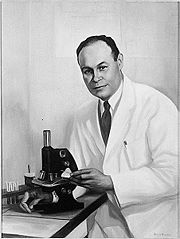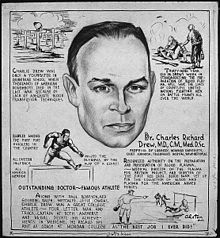- Charles R. Drew
-
This article is about the medical researcher. For the politician and army officer, see Charles r. Drew. For the ship, see USNS Charles Drew (T-AKE-10).
Charles Richard Drew 
Charles Richard DrewBorn June 3, 1904
Washington, D.C., USADied April 1, 1950 (aged 45)
Burlington, North Carolina, USANationality United States Fields General Surgery Institutions Freedman's Hospital
Morgan State University
Montreal General Hospital
Howard UniversityAlma mater Amherst College, McGill University, Columbia University Doctoral advisor John Beattie Known for Blood banking; blood transfusions Notable awards Spingarn Medal Charles Richard Drew (3 June 1904 – 1 April 1950) was an American physician, surgeon and medical researcher. He researched in the field of blood transfusions, developing improved techniques for blood storage, and applied his expert knowledge to developing large-scale blood banks early in World War II. This allowed medics to save thousands of lives of the Allied forces.[1] The research and development aspect of his blood storage work is disputed.[2] Drew protested against the practice of racial segregation in the donation of blood, as it lacked scientific foundation, an action which cost him his job. In 1943, Drew's distinction in his profession was recognized when he became the first black surgeon selected to serve as an examiner on the American Board of Surgery.
Contents
Early years
Drew was born to Richard Thomas Drew and Nora Burrell in Washington, DC.[3][4] He attended Meads Mill Elementary School, and began working as a paperboy selling copies of the Washington Times-Herald while attending school. In 1918, he enrolled at Dunbar High School, a racially segregated high school with a reputation for being one of the strongest academic African-American public schools in the country. Drew’s sister Elsie, who was ailing with tuberculosis, died of pandemic influenza in 1920. Her death influenced his decision to study medicine.
His athletic achievements helped win him a scholarship to Amherst College in Massachusetts and he graduated in 1926.[5] An outstanding athlete at Amherst, Drew also joined Omega Psi Phi fraternity. He attended medical school at McGill University in Montreal, receiving his M.D. in 1933 as well as a Master of Surgery degree,[5] and ranked 2nd in his class of 127 students.[5] A few years later, Drew did graduate work at Columbia University, where he earned his Doctor of Medical Science degree, becoming the first African American to do so.[5]
Academic career
Dr. Drew became a researcher and general surgeon, teaching and practicing within medical schools and teaching hospitals. He worked and taught at Freedman's Hospital, Morgan State University, Montreal General Hospital and Howard University.
Soon after he began his career due to his excellence, Dr. Drew was selected in 1943 as the first black surgeon to serve as an examiner on the American Board of Surgery. Drew had a lengthy research and teaching career, and became a chief surgeon.
Blood Plasma for Great Britain Project
In late 1940, during World War II before the US entered the war, and just after earning his doctorate, Drew was recruited by John Scudder to help set up and administer an early prototype program for blood storage and preservation. He was to collect, test, and transport large quantities of blood plasma for distribution in Great Britain.[6] Drew went to New York to direct the United States' Blood for Britain project. The Blood for Britain project was a project to aid British soldiers and civilians by giving US blood to Great Britain.
Drew created a central location for the blood collection process where donors could go to give blood. He made sure all blood plasma was tested before it was shipped out. He ensured that only skilled personnel handled blood plasma to avoid the possibility of contamination. The Blood for Britain program operated successfully for five months, with total collections of almost 15,000 people donating blood, and with over 5,500 vials of blood plasma.[6] As a result, the Blood Transfusion Betterment Association applauded Drew for his work. Out of his work came the American Red Cross Blood Bank.
Death
From 1939, Drew attended the annual free clinic at the John A. Andrew Memorial Hospital in Tuskegee, Alabama. For the 1950 Tuskegee clinic, Drew and three other black physicians decided to drive rather than fly. Drew was driving around 8 a.m. on April 1. Still fatigued from spending the night before in the operating theater, Drew lost control of the vehicle. After careening into a field, the car somersaulted three times. The three other physicians suffered minor injuries. Drew was trapped with serious wounds; his foot had become wedged beneath the brake pedal. When reached by emergency technicians, Drew was in shock and barely alive due to severe leg injuries. Drew was taken to Alamance General Hospital in Burlington, North Carolina. He was pronounced dead a half hour after he first received medical attention. Drew's funeral was held on April 5, 1950, at the Nineteenth Street Baptist Church in Washington, DC.
A persistent urban legend (even recounted in an episode of the TV show M*A*S*H and Philip Roth's The Human Stain) holds that Drew was denied care — ironically, a blood transfusion — at a nearby hospital because of his race and bled to death. In fact, Drew was well treated by the hospital. Claims that he was not treated because of his skin color are unfounded.[7] As Dr. John Ford, one of the doctors traveling with Drew, later explained, "We all received the very best of care. The doctors started treating us immediately. [...] He had a superior vena caval syndrome—blood was blocked getting back to his heart from his brain and upper extremities. To give him a transfusion would have killed him sooner. Even the most heroic efforts couldn't have saved him. I can truthfully say that no efforts were spared in the treatment of Drew, and, contrary to popular myth, the fact that he was a Negro did not in any way limit the care that was given to him."[8]
Legacy and honors
- 1981, the United States Postal Service issued a 35¢ postage stamp in its Great Americans series to honor Drew.
- 2002, scholar Molefi Kete Asante listed Drew as one of the 100 Greatest African Americans.[9]
- Charles R. Drew Memorial Bridge, Brookland neighborhood, Washington DC[10]
- USNS Charles Drew (T-AKE-10) is a dry cargo ship of the United States Navy
- Parc Charles-Drew, in Le Sud-Ouest, Montreal, Quebec, Canada
Numerous schools and health-related facilities, as well as other institutions, have been named in honor of Dr. Drew.Medical and higher education
- In 1966, the Charles R. Drew Postgraduate Medical School was incorporated in California and was named in his honor. This later became the Charles R. Drew University of Medicine and Science.
- Charles Drew Health Center, Omaha, Nebraska [11]
- Charles Drew Science Enrichment Laboratory, Michigan State University, East Lansing, Michigan [12]
- Charles Drew Health Foundation, East Palo Alto, California, 1960s-2000, was the community's only clinic for decades.
- Charles Drew Community Health Center, located in Burlington, NC near the site of the old Alamance County hospital.
- Charles R Drew Wellness Center in Columbia, South Carolina[13]
- Charles R. Drew Hall, an all-male freshman dorm at Howard University, Washington D.C.[14]
- Charles Drew House, residence at Amherst College, his alma mater
K-12 schools
- Charles R. Drew Junior High School, Detroit, Michigan
- Charles Drew Science Magnet School, Buffalo, NY
- Charles R. Drew Elementary School, Miami Beach[15] and Pompano Beach, Florida[16]
- Bluford Drew Jemison S.T.E.M Academy, Baltimore(www.BDJacademy.com), and Dr. Charles R. Drew Elementary School, Colesville, Maryland[17]
- Charles R. Drew Elementary School, Arlington, Virginia
- Dr. Charles Drew Elementary School, New Orleans, LA
- Charles R. Drew Charter School opened in August 2000 as the first charter school in Atlanta, Georgia
- Charles R. Drew Elementary School, and Charles Drew Academy at Anacostia High School, Washington, DC
- Dr. Charles R. Drew Elementary School, San Francisco, CA
- Charles R. Drew Transition Center Post Secondary Center Based Educational Center, Detroit, Michigan
References
- ^ "Patent For Preserving Blood Issued November 10, 1942; Washingtonian's invention made Washingtonian's invention madeblood bank possible" (Press release). Brigid Quinn, United States Patent and Trademark Office. 9 November 2001. http://www.uspto.gov/web/offices/com/speeches/01-52.htm. Retrieved 2009-02-03.
- ^ Charles E. Wynes, Charles Richard Drew: The Man and the Myth (Urbana, IL: University of Illinois Press, 1988), p. 58.
- ^ Blackpast.org's biography
- ^ Spencie Love's "One Blood: The Death and Resurrection of Charles R. Drew" p. 98
- ^ a b c d Charles Drew page at blackinventor.com. Retrieved 2011-06-26.
- ^ a b Starr, Douglas P. (2000). Blood: An Epic History of Medicine and Commerce. New York: Quill. ISBN 0688176496.
- ^ Spencie Love, One Blood: The Death and Resurrection of Charles R. Drew, The University of North Carolina Press (October 29, 1997), p4 ISBN 0-8078-4682-1 Retrieved 2009-06-19
- ^ Cecil Adams (10 November 1989). "Did the black doctor who invented blood plasma die because white doctors wouldn't treat him?". The Straight Dope. http://www.straightdope.com/classics/a5_073.html. Retrieved 2009-02-03.
- ^ Asante, Molefi Kete (2002). 100 Greatest African Americans: A Biographical Encyclopedia. Amherst, New York. Prometheus Books. ISBN 157392968.
- ^ http://www.hmdb.org/marker.asp?marker=6262
- ^ Charles Drew Health Center
- ^ About Dr. Charles R. Drew, Charles Drew Charles Drew Science Enrichment Laboratory, Michigan State University
- ^ http://www.drewwellnesscenter.com/index.asp
- ^ Charles R. Drew Hall, Howard University
- ^ Charles R. Drew Elementary School, Miami-Dade County Public Schools
- ^ Dr. Charles R. Drew Elementary School, Broward County Public Schools
- ^ Dr. Charles R. Drew Elementary School, Montgomery County Public Schools
Further reading
- Schraff, Anne E. (2003) Dr. Charles Drew: Blood Bank Innovator Enslow, ISBN 0-7660-2117-3
- Love, Spencie (1996) One Blood: The Death and Resurrection of Charles R. Drew, Chapel Hill: University of North Carolina Press, (1997 reprint) ISBN 0-8078-4682-1
- Wynes, Charles E. (1988) Charles Richard Drew: The Man and the Myth University of Illinois Press, ISBN 0-252-01551-7
- Organ, Claude H., editor, ( 1987 ) A Century of Black Surgeons: The USA Experience, Transcript Press, ISBN 0-9617380-0-6 Vol. I, Asa Yancey, Sr., Chapter 2: The Life Of Charles R. Drew, MD
External links
- SBAS Charles Drew - Black American Medical Pioneer
- "Biography of Charles R. Drew", Charles R. Drew University of Medicine and Science
- "Charles R. Drew Papers", online collection by the National Library of Medicine
- "Charles R. Drew", The Straight Dope
- Charles Drew, Florida State University
- Charles Drew - The Black Inventor, Online Museum
Categories:- African Americans in science
- Amherst College alumni
- Columbia Medical School alumni
- People from Washington, D.C.
- Road accident deaths in North Carolina
- McGill University alumni
- 1904 births
- 1950 deaths
- Spingarn Medal winners
- African-American physicians
- African American surgeons
Wikimedia Foundation. 2010.


